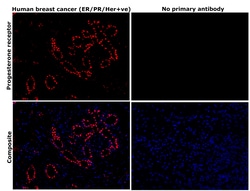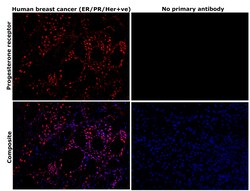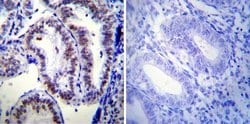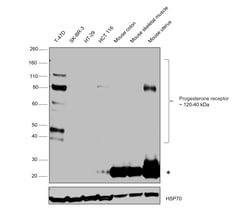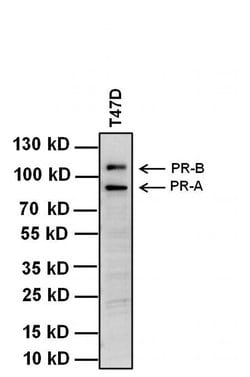Learn More
Invitrogen™ Progesterone Receptor Monoclonal Antibody (PR-AT 4.14)
Mouse Monoclonal Antibody
Supplier: Invitrogen™ MA1410
Description
MA1-410 detects the progesterone receptor (PR) from human, non-human primate, bovine, rat, rabbit, and mouse tissues. This antibody does not cross-react with androgen receptor, estrogen receptor or glucocorticoid receptor. MA1-410 has been successfully used in Western blot, immunohistochemical and immunoprecipitation procedures. By Western blot, this antibody detects a 94 kDa and a 120 kDa protein representing PRA and PRB, respectively from T47D whole cell lysate. MA1-410 performs better by western blot using BSA as the blocking agent and in antibody diluent. The MA1-410 immunogen is a synthetic peptide corresponding to the binding domain residues G(533) L P Q V Y P P Y L N Y L R P(547) of human Progesterone Receptor. MA1-410 can be used with blocking peptide PEP-016.
The progesterone receptor (PR) is a member of the steroid family of nuclear receptors. The PR mediates the physiological effects of progesterone, which plays a central role in reproductive events associated with the establishment and maintenance of pregnancy. PR is found as a 94 kDa protein (Form A) or a 120 kDa protein (Form B) due to the use of alternative translation initiation sites. PR-B is the transcriptionally active form and is responsible for activating genes for the maintenance of the endometrium, maintenance of pregnancy, and inhibition of ovulation. PR-A is identical to PR-B except for a 165 amino acid deletion at the N-terminus. This deletion exposes a 140 amino acid inhibitory domain (ID) that acts as a repressor of steroid hormone transcriptional activity. In its inactive state, PgR forms a multiprotein complex which includes heat shock proteins and immunophins. Upon binding of progesterone hormone to its receptor, there is a conformational change that allows dimerization and binding of the receptor to progesterone response elements (PRE) sequences, resulting in activated transcription. A Null mutation in the PGR gene leads to pleiotrophic reproductive abnormalities.
Specifications
| Progesterone Receptor | |
| Monoclonal | |
| 1 mg/mL | |
| PBS with 1 mg/mL BSA and 0.05% sodium azide | |
| P06186, P06401, Q00175, Q63449 | |
| PGR | |
| Synthetic peptide corresponding to residues G(533) L P Q V Y P P Y L N Y L R P(547) of human Progesterone Receptor. | |
| 100 μg | |
| Primary | |
| Human, Mouse, Rat, Rabbit, Monkey, Bovine | |
| Antibody | |
| IgG1 |
| ChIP Assay, Immunohistochemistry (Frozen), Immunohistochemistry (Paraffin), Immunoprecipitation, Western Blot | |
| PR-AT 4.14 | |
| Unconjugated | |
| PGR | |
| 9930019P03Rik; BB114106; ENSMUSG00000074510; LOW QUALITY PROTEIN: progesterone receptor; NR3C3; Nuclear receptor subfamily 3 group C member 3; p4 receptor; PGR; pot. alt. progesterone receptor; putative; PR; PR-A; PR-B; Progesterone receptor; progesterone receptor A; progesterone-receptor; putative form B; steroid hormone receptor; testicular progesterone receptor; unnamed protein product | |
| Mouse | |
| Protein A | |
| RUO | |
| 100009094, 100848466, 18667, 25154, 5241 | |
| -20°C, Avoid Freeze/Thaw Cycles | |
| Liquid |
Safety and Handling
Your input is important to us. Please complete this form to provide feedback related to the content on this product.
